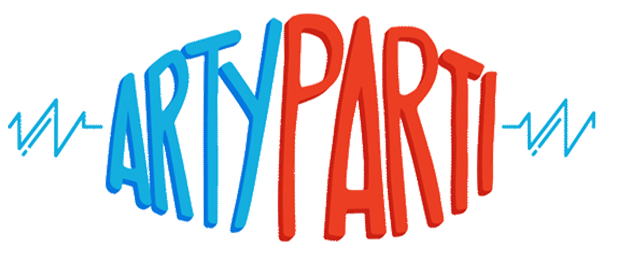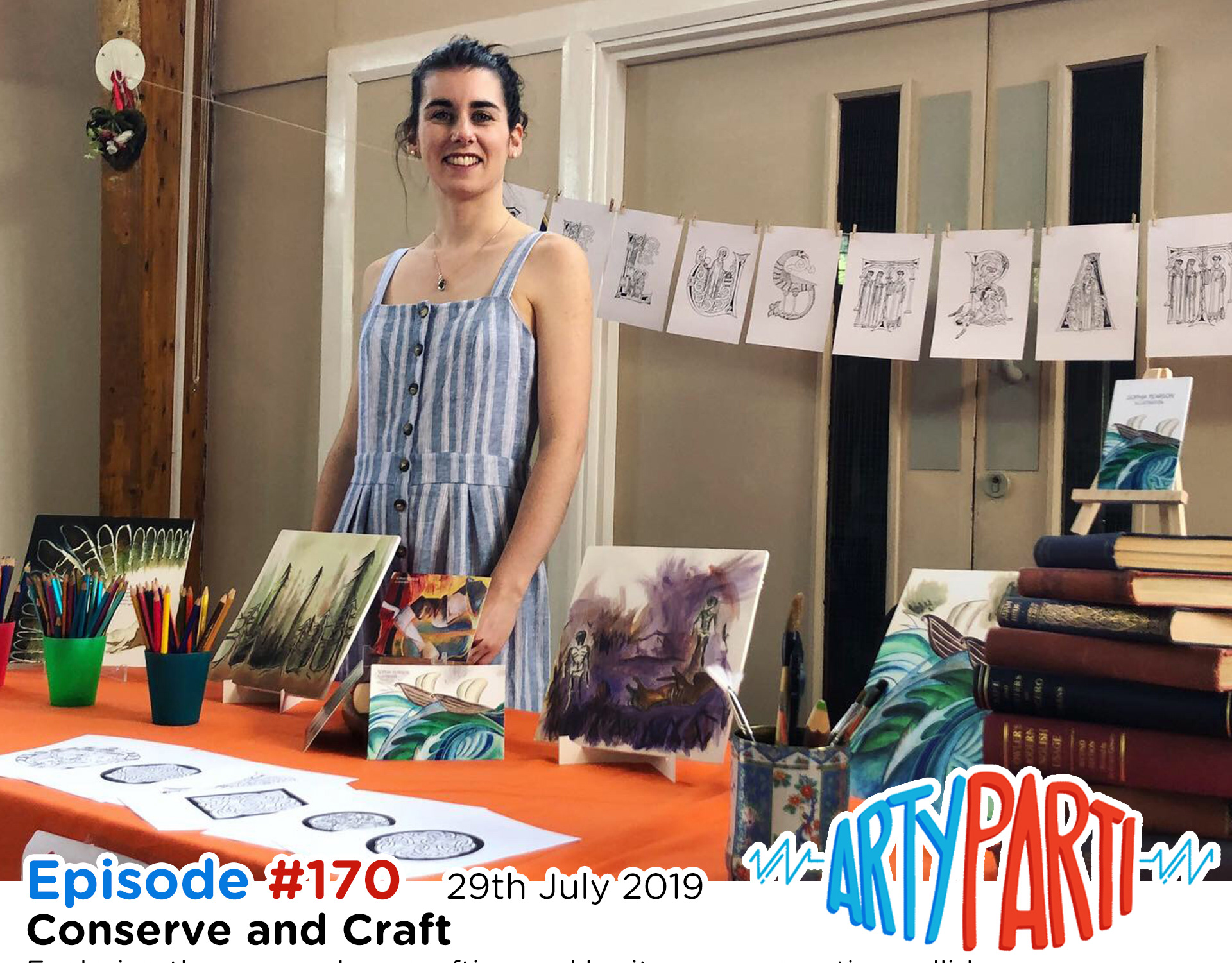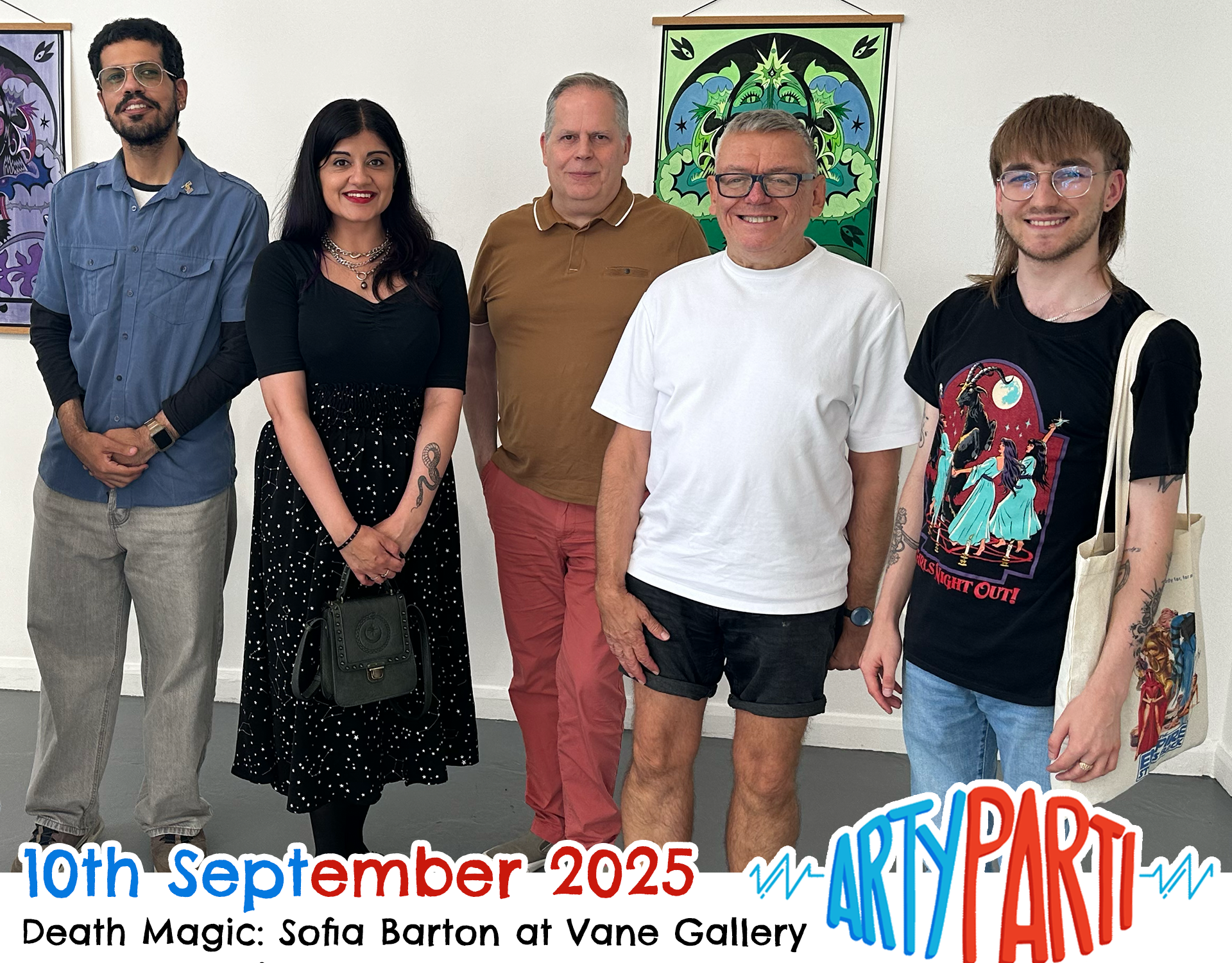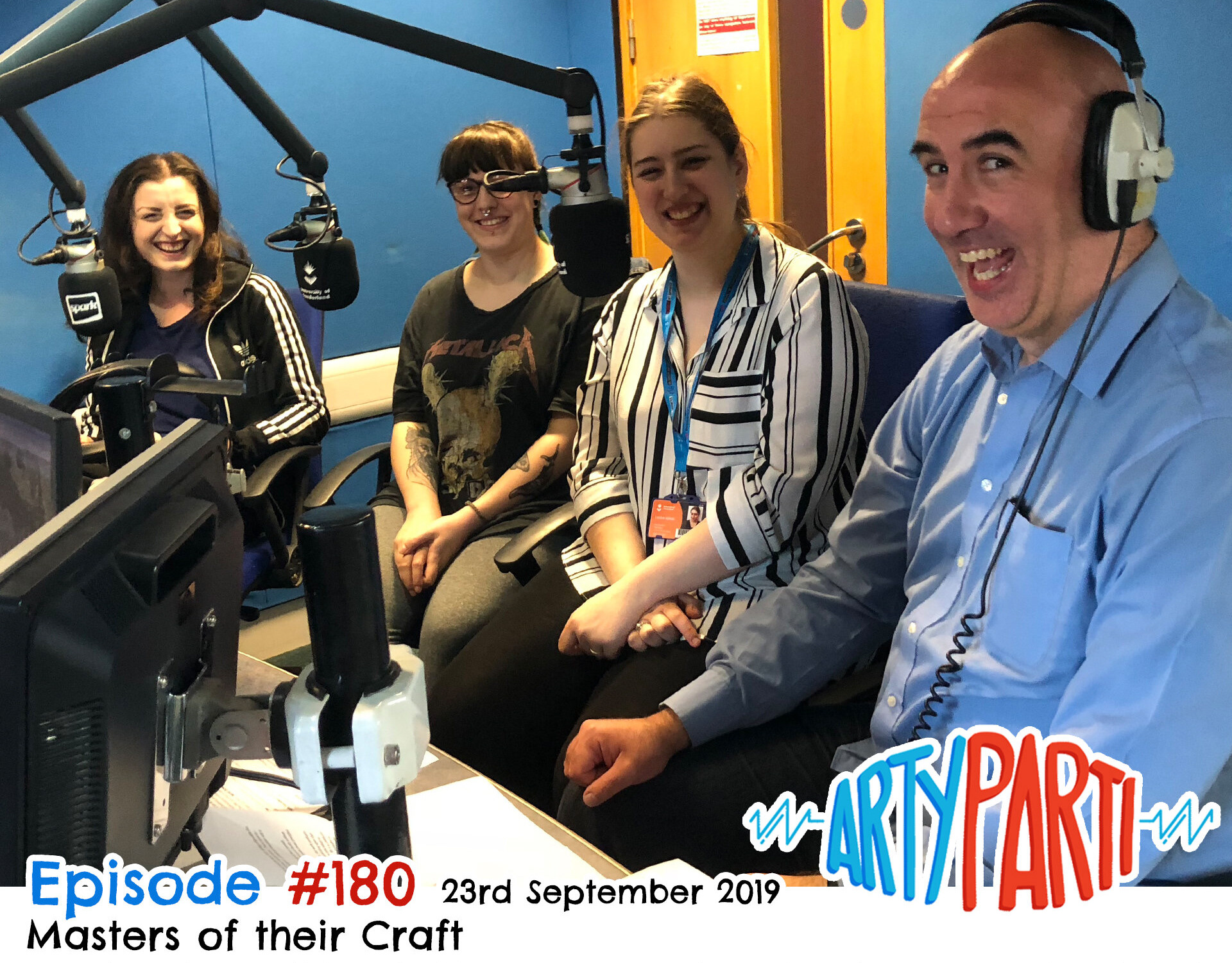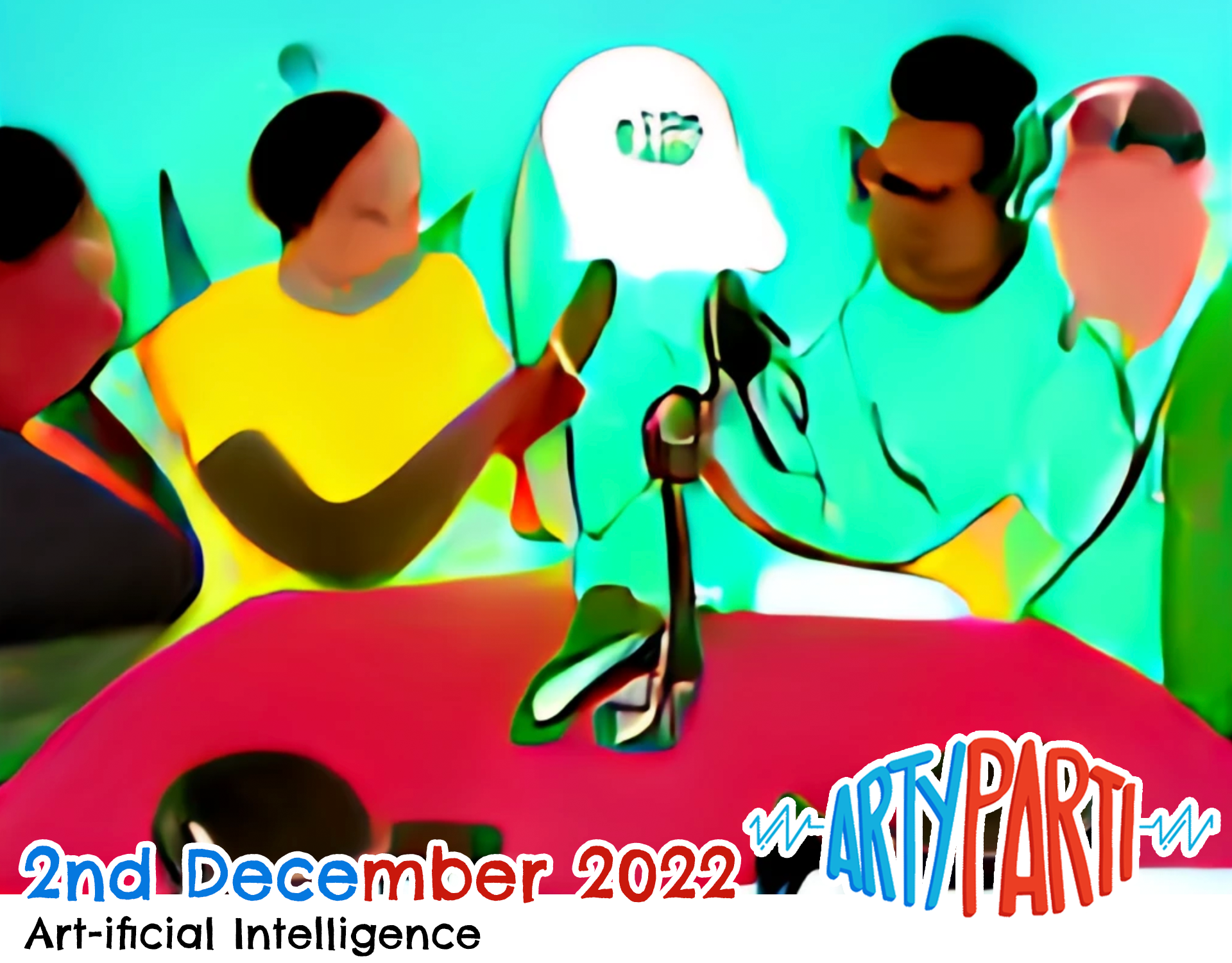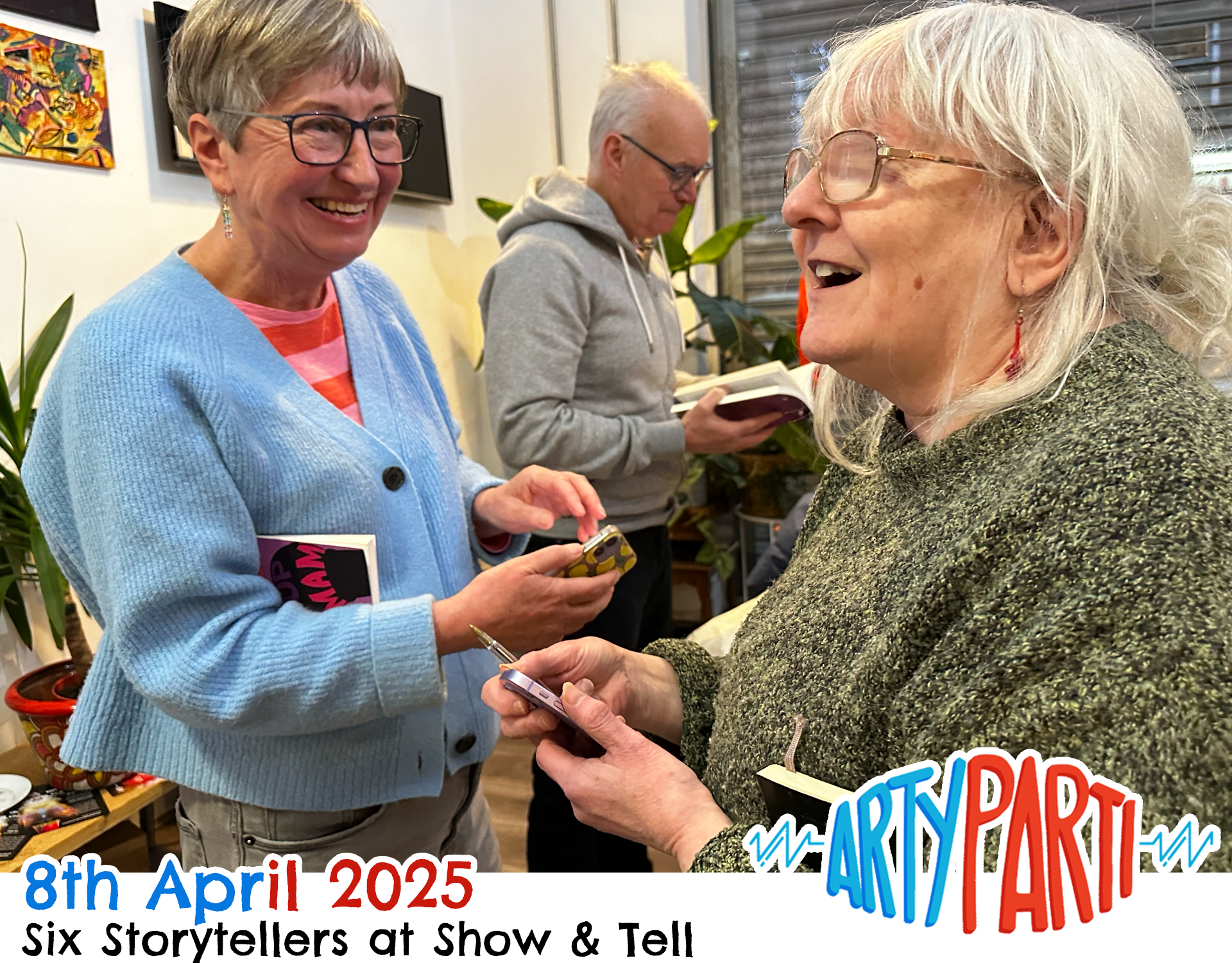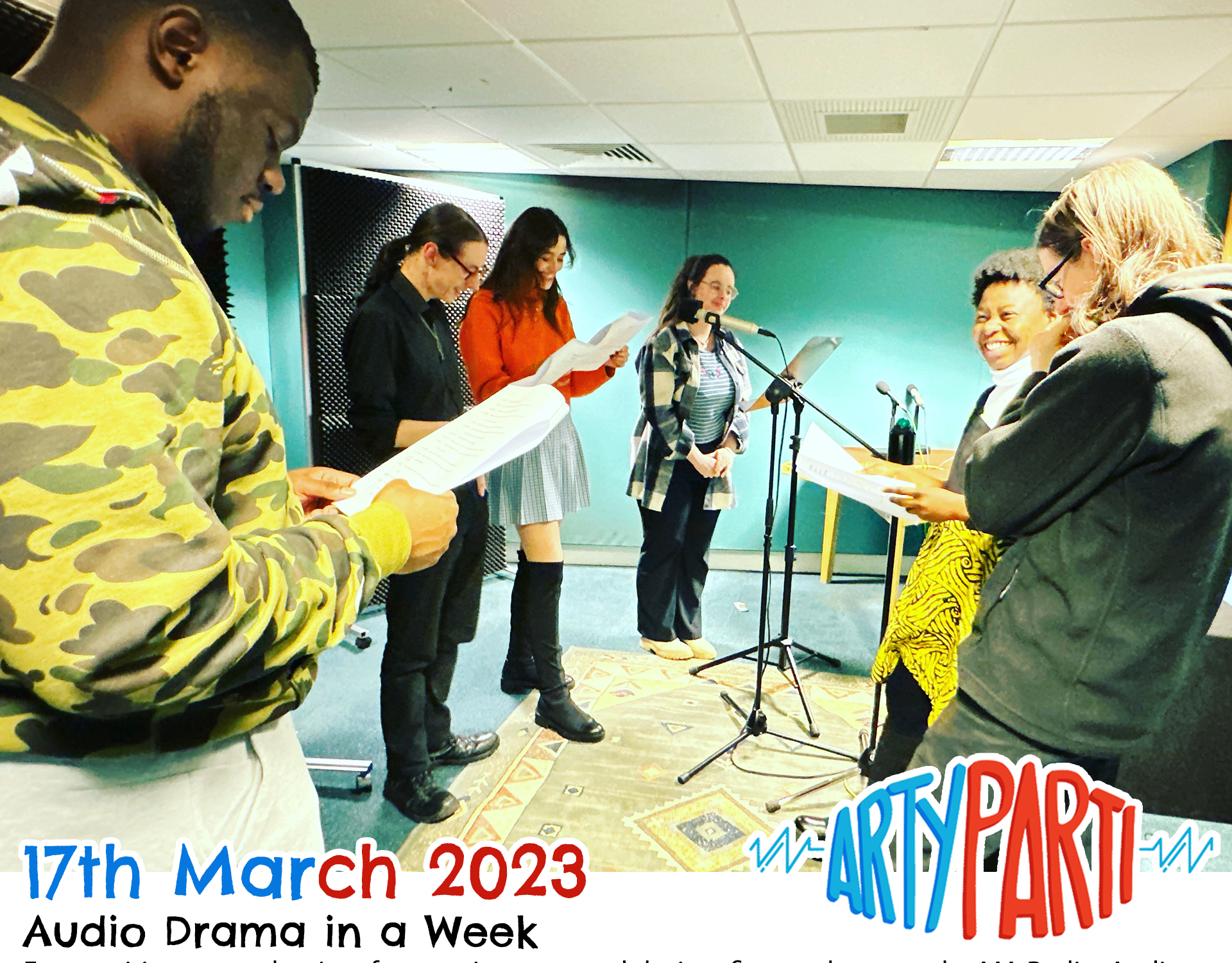JO HOWELL [00:15:52] Richard Bliss is doing "The Working Man's Shirt". So he's basically honouring all of the workmen who might have built the museum or help maintain it, which obviously aren't really as present in the objects themselves. So that's a nice nod to the working class people. Caroline's been mainly influenced by the architectural designs and drawings of the building, and taken a really interesting Japanese paper style on that. I chose the botany cabinet as my object to launch into the project. A botany cabinet - well we don't have them now because it's a ridiculously posh thing to have. So the botany cabinet's a Georgian piece of furniture, with beautiful walnut carvings and things on it, but it was used to house plants. So it was literally, it was for botany specimens - so they'd be like water, and seedlings, and all those kind of things in it. So it really piqued my interest because it's such a weird object. Like, there's no way that you would be putting all your plants in a beautiful wooden cabinet these days. But of course, it just shows the signs of the times. If you had the money, then you could spend it on beautiful botany cabinets. [CHUCKLE] So the botany cabinet was the object that brought us in the project, but what it led us to research was the life of the person who owned the botany cabinet. What I found, my interest is quite often in creating artworks in the landscape and of the landscape. But as a side note, what had started happening was finding out this really interesting feminist story about the owner. So, Mary Eleanor Bowes was a long distant relationship of the queen, and she was the richest heiress at the time, and she had hung around with people called the Blue Stocking Brigade, which was basically women who just wanted to learn and access institutions. So there's this really interesting kind of story of suffrage that's attached to the botany cabinet that I found really quite symbolic. And I just thought that we should highlight these stories of heroines from the past to kind of reclaim them, to claim them back. Mary Elenanor Bowes was particularly unlucky due to the patriarchy at the time in Georgian times. She was obviously her husband's property, that's how it was. And she had a prenup that stopped her husband from getting all of the money, which he didn't like, obviously. And so he spent about eight years kind of forcing her to write "The Confessions of the Countess of Strathmore", and vilifying her in newspapers, and taking her kids away from her - like, really, really heinous kind of stuff. But at the end of the day, she was one of the first women to get a divorce and to retain her property. So, all of that's wrapped in, in this absolutely mad botanical cabinet. Because, obviously, objects have stories and lives. That "her-story" thing - let's reclaim all of those female stories that are maybe kind of misrepresented, or just non-existent in the public. SOUNDS [00:18:55] [THEME MUSIC BY SOUND ARTIST MUSELEON]
JAY SYKES [00:18:55] I then went upstairs to meet Judy Dibiase, who made this collection of 200 cups that we were talking about earlier, which visitors to the #Untitled10 exhibition were invited to take away in exchange for memory. And she was chatting with Emmanuela Roth, who is reading a collaborative doctoral project with the Bowes Museum and Durham University. Both of their work is focussed on Joséphine Bowes. Joséphine was one of the two founders of the Bowes Museum, alongside her husband John Bowes. And when I went upstairs to meet Judy, they were both talking very excitedly about how their practice was aligned around Joséphine Bowes.
EMMANUELA ROTH [00:19:42] To me, as soon as I see someone taking an interest in Joséphine and doing something great, I'm was like so excited, like "yay!".
JUDY DIBIASE [00:19:47] [LAUGHS] Oh well, that's really good!
EMMANUELA ROTH [00:19:54] I'm not the only one who cares about her, [LAUGHS] there's others! And what Kitt is doing, as well, is really exciting. Like, especially when you do a PhD, you do something which people are like "oh, that's so niche." It's like, "is it?" It's a massive museum, it's the founder, like, it's not that niche. But inevitably, you rarely come across someone who's kind of as passionate about your subject as you are. So when you stumble across someone who's done, you know, a whole installation on the person that you are very interested in - and such an exciting, imaginative, creative thing, which I'm definitely gonna run downstairs in a minute and make sure I get one of these cups! But no, it's super exciting, and I think we're doing Joséphine a bit of justice. I'm just loving meeting these women who have a similar passion to me, and in our own different ways, within our own form and how we can do it..
JUDY DIBIASE [00:20:43] We're talking the same language, yeah, yeah.
EMMANUELA ROTH [00:20:43] And again, we're coming back to not just using words, in the same way that through objects, through... I'm going to be looking at music, and her theatre, and her costume, and, you know, other things beyond beyond the written word. So it's super exciting. And thank you [JAY] for also continuing the conversation, you're part of this too, it's not just us. [LAUGHS] It's exciting, yeah.
JUDY DIBIASE [00:21:07] I think it's.. It's these women in history who are not necessarily being - I mean, there’s so many more who are not recognised, who don't even hit historic radar, really. So we have to explore the ones who are there, who we have got evidence for, because there would have been thousands who would have just gone under the radar. And so, we owe it to the ones who least hit the radar to push it as far as we can.
EMMANUELA ROTH [00:21:31] Absolutely. And that's what I'm finding in my research. When I was in Paris a couple weeks ago, digging up these archives of all these forgotten female artists..
JUDY DIBIASE [00:21:39] Yeah.
EMMANUELA ROTH [00:21:39] In fairness, like, generally, artists get in that sense, in terms of theatre performers, actors aren't as well remembered cause their art's quite ephemeral and quiet.. So there is that element, but there's still obviously gender issues at play. And so I'm discovering all these stories about other women which haven't been looked at yet. And Joséphine is making that happen - because by inspiring this project, these other people are getting a look-in. Yeah, it's unearthing other stories, and "herstory", or "her-itage", or whatever you want to call it.
BOTH [00:22:13] [LAUGH]
EMMANUELA ROTH [00:22:17] Yeah, I love a bit of wordplay.
JUDY DIBIASE [00:22:21] I've been very interested in Joséphine Bowes and her collecting, and her relationship with objects. There's very little information about her really, but obviously she's key to the building, and she's particularly key to the ceramics collection. That's what drew me to her as a woman. And I wanted to find out more about why she collected her relationship with objects, how she perceived objects, because it's a very definite relationship. So I was kind of looking for that kind of evidence, really. You can't help it if you're a woman practitioner to be very aware of women who are - well, for me, she was interested in ceramics. Why was she interested in ceramics? This is the biggest European collection of ceramics, so that was my attraction to her. But I just think as a woman, you are naturally attracted to finding out about women who were interested in objects, who were interested in historical connections. So yeah, I wanted to find out more, and obviously I've just touched the surface. It's just been such a small project. But I just wanted to know why - why did she want to collect all this stuff?
EMMANUELA ROTH [00:23:31] I'm Emmanuela Roth. I'm doing a collaborative doctoral project between Durham University and the Bowes Museum. I'm just coming into my second year. And Joséphine Bowes is the sort of inspirational case study to the project. So, obviously women historically have often been overlooked and also popular theatre, which is what Joséphine was doing before she married John and moved here, has also been largely overlooked because musicalogically high art, and so opera, and what was considered to be worthy of academic pursuit has been researched, and low art, popular theatre, hasn't. So, both from an academic musicalogical perspective of popular theatrical history, and from a female history, there's a big gap. This is why you don't know that Joséphine was a cross-dressing actor.
JUDY DIBIASE [00:24:21] No, no. I didn't know that.
EMMANUELA ROTH [00:24:25] This information isn't available.
JUDY DIBIASE [00:24:26] You have to dig to get her story, but you don't have to dig to get John's.
EMMANUELA ROTH [00:24:26] Yeah.
JUDY DIBIASE [00:24:27] At all.
EMMANUELA ROTH [00:24:27] No.
JUDY DIBIASE [00:24:27] So we have to really hunt to find the real Joséphine, Joséphine story, and why did she do these things. Whereas John's is kind of laid out for us, like a seamless line.
EMMANUELA ROTH [00:24:40] Yeah. Both because at the time he was documenting it a lot more as a man, and because historically people have been more interested in him, and that's who's been written about. Yeah, I'm trying to dig up a bit of the dirt - quite literally - on Joséphine. Do that through, if I can't find more written documentation, I can look up her portraiture and her collection. You know, her stage name was Mademoiselle Delhomme, which is the name of a 17th century courtesan. And a play at the time, a popular theatrical play by Victor Hugo, was called Marionne Delhomme. So she's almost certainly chosen a stage name that is about a courtesan, so a sex worker. So, you know, that is an identity that she was very much associating herself with at one point. Similarly, the portrait of her, the white dress, the official portrait is..
JUDY DIBIASE [00:25:35] The one..
EMMANUELA ROTH [00:25:35] The one of her in a white dress at the table, with the dogs.
JUDY DIBIASE [00:25:36] Yes, yes, yes, yes, yes.
EMMANUELA ROTH [00:25:38] That is basically reimagination of the Madame Pompadour painting at the National Gallery. If you look at them - and Pompadour was a famous mistress, she was one of the Royal King mistresses. And of Josephine's collections of the paintings in her room, one of them, again, looks like [it] probably was Madame Pompadour. And if you look at her book collection, she's got so many books written by courtesans and women who would have been mistresses. I'm seeing this kind of celebration of this, even if it's on the personal private level, and not in a public.. There's kind of hints to this. And so, you know, is this kind of lack of knowledge about her life before she got here..
JUDY DIBIASE [00:26:20] Deliberate? Yeah.
EMMANUELA ROTH [00:26:22] And even if it isn't, we still want to know about her. And there's time to dig a little deeper.
JUDY DIBIASE [00:26:27] Yeah. Yeah. But there's so little to access.
EMMANUELA ROTH [00:26:30] And from here, there's lots of information that needs to be brought out publicly.
JUDY DIBIASE [00:26:35] Oh, I agree.
EMMANUELA ROTH [00:26:35] Because if you look at Kitt's thing over there, which is amazing, the Sappho stuff, you know, they talk about being queer and, you know.. "I love the Bowes, but how do I fit in here?" Their story needs to be told. And, you know, talking about the fact that Josephine was a cross-dressing artist and had this kind of queer aesthetic, in terms of preacher's roles, and things like that. And, you know, this amazing statue of Sappho that they presumably collected. 1848, Joséphine's alive and well.
JUDY DIBIASE [00:27:07] Yeah.
EMMANUELA ROTH [00:27:07] What are these stories, like, what what's going on there? Let's talk about that, because.
JUDY DIBIASE [00:27:13] Narrative.
EMMANUELA ROTH [00:27:13] I'm done with the Goya.
JUDY DIBIASE [00:27:14] [LAUGHS].
EMMANUELA ROTH [00:27:14] Like that's great, but like.. It's exciting.
LADY KITT [00:27:17] I grew up coming here a lot, yeah. So I grew up in Bishop Auckland, which is just down the road. There's quite like an important moment for me that I had here at this museum. They had an exhibition years ago, '96 or something maybe? In some ways, it wasquite similar to #Untitled10, actually, they'd invited artists to either bring work and install it, or create work in response to things in the museum. And it was a really.. One of those moments when you just go, "Whoa! This is where art can be! I think I might love this, like, I think I might want to do this is! Arrgh!" So it's really special to be one of these artists, and come back here as an adult and as a practicing artist, to this place where I had one of those kind of magical "Oh, my God, I think I want to do art" moments. So it's been dead special. I think like any of those things, it sort of hits you in phases, doesn't it? [LAUGHS] So when I heard about the opportunity, I thought, "whoa, that's astonishing, isn't it?" Because that places is, like, really special to me. And then when I found out that I was one of the 10 artists, I was.. [MAKES A NOISE LIKE SHE'S SPEECHLESS] "Aargh!" And then there've been points along the way where I've had that [INTAKE OF BREATH] feeling. Yeah. And obviously tonight is one of those as well, because, here is, you know. I came in and I went upstairs, and I saw my work, and I was like, "whoa, here it is!" [LAUGHS] Yeah, it's pretty special.
JO HOWELL [00:28:52] Lady Kitt (I love this project) has focussed in on Sappho. For those of you who might know who Sappho is, she's very important in Ancient Greece. She basically set up the island of Lesbos, which was mainly for women, or, you know, liberal minded people. Sappho for is quite an important gay icon in particular, like, for lesbians. LADY KITT [00:29:17] I would keep talking about, "ah, Sappho, my mate, Sappho!" But yeah, not everybody knows who Sappho is, obviously. [LAUGHS] So, Sappho was a Greek poet, fifth century B.C., and she wrote these really, like, astonishing poems about all sorts of stuff. But there's like a big body of love poems, and they're to men and to women. And so she has become this sort of queer icon. And I was quite interested in the fact that there's basically none of that in the museum's interpretation upstairs. So the text by that amazing statue is incredibly coy about the fact that she was probably bisexual, and there's just like not really anything about that there at all. And I thought "ahh, that's just a missed opportunity, isn't it?" Like, that's a great way to bring LGBTQ history into the museum and to talk about that. And it's sort of been.. It's been missed. Straight away, I knew that that's why I would be interested in doing here.
JO HOWELL [00:30:18] In the museum collection, it's not really discussed like that, in the way that the descriptions are written. It's kind of, you know, "she was very fond of women" is the way that they've kind of written it. I understand the trouble that a museum might have about possibly discussing these things. What I found interesting about Lady Kitt's project was the fact that we get to start having these dialogues about, again, all of these people who are missing from the stories. She was a lesbian, let's celebrate that. She loved women. She wrote poetry. Fantastic. Why can't we write that on the description? LADY KITT [00:30:53] In response to the very coy interpretation about Sappho and who she is, I've made this great big, huge, bright pink and purple paper shrine to Sappho. [LAUGHS] And, also created some performance work, in collaboration with an amazing performance collective called DGA, who are based in Newcastle.
JO HOWELL [00:31:17] If we're wanting to have an inclusive society, then we can't ignore the fact that we are different, and these many differences are what make was brilliant. To suddenly imagine that, "oh well, you know, there was only heterosexuality up until very recently" is insane. Kind of whitewashing it out of our history is... It's something that we do need to address. And Lady Kitt's done in a really fun kind of fashion. LADY KITT [00:31:46] I think initially I was just thinking about, well, who's Sappho to me? And my response, and the contemporary kind of reading of who she is. But the more I thought about it, the more research I did, the more I was really interested in the way that she's been so variously portrayed. There was a certain view of Sappho and she was the sort of a tragic character, and a lot of stuff kind of depicts her about to commit suicide, like half toppling off a cliff. I mean historians disagree about most stuff about Sappho, because really there's just not much there about her. There's her work, and there's not much left of that. And there are people, centuries after she died, talking about how astonishing her work was, how amazing she was, how idiotic she was, you know, a wide variety of ideas about her. Really, like, astonishingly different ideas of who she was and what she was up to. So there are all these historical ideas of who she was, and then there's just her amazing poetry. So I was talking about this shrine that I've made upstairs, and I've made some figures of her underneath that. I've made a big paper boat, and I've just cut some of her lines of poetry into the boat because I think it's quite important to look at those and think about how beautiful they are, just understand how beautiful they are, and how relevant they still are today as well.
JUDY DIBIASE [00:33:18] [ABOUT JOSÉPHINE BOWES] I also wanted to know why she collected particular objects, and I think therefore it's very interesting to hear Emmanuela talk about, you know, Sappho, which they would have collected. If I had dug deeper, I would have found out about Joséphine's relationship with cross dressing. And so, therefore, I think objects tell us so much about somebody. I wanted to find out more about her because there's so little that we've established. And, yeah, we talk about this as being the collection of John and Joséphine Bowes, but.. There's a lot about him, not much about her.
LADY KITT [00:33:53] Because until you know about any historical character, or anything, you you can't begin to have a relationship with them, or understand what they mean to you, or what they mean to your community, or highlighting and inviting people to find their own relationship, I guess, with the objects, and also with the stories that resonate with them through those objects.
JO HOWELL [00:34:18] These kind of initiatives with museums are really fantastic, and it's something that has really been under utilised. So, I guess my thing would be saying to the commissioners out there who might be listening - "The value that you're going to get from making objects in your collections more visible, and to have them interpreted by different people, will open them up again for lots of new audiences. You know, sometimes these stories can get a bit stale, you know, let's inject some art and creativity into it. And, yeah, museums - start doing artist residences as par for course. JAY SYKES [00:34:59] Should there be more of this? Other museums?
LADY KITT [00:35:03] Oh, God. Yeah. So much. I think... I have two little children, five and eight, and take them to museums and galleries quite a lot. And so often we wander around and I just think, "oh, this is just..." It might be a lovely museum, and there might be interesting stuff in it, but it is just being presented through such a white male privileged lens. [SIGH] Man, it's the 21st century, isn't it? That's really disappointing. And I... I don't want my kids going to museums where that's the view of history. You know, it's so restrictive. So, yeah, I definitely think museums should be should be doing this, it's really important - getting lots of different people in to rummage around and eke out different stories, and different ways of experiencing and understanding collections. Yeah.
JAY SYKES [00:36:02] Well, it's 9:00 o'clock here at the Bowes Museum, and wrapping up at the #Untitled10 exhibition. It's been a pleasure tonight to meet four of the artists who are exhibiting. Of course, you can find out more information about all of the 10 different artists if you search for the #Untitled10. Lots of information about there, or, of course, on the Bowes Museum website. Jo Howell, the woman who invited me tonight.. JAY SYKES [00:36:28] I've had so much fun meeting artists, Jo.
JO HOWELL [00:36:29] Good. There's lots of interesting people, isn't there? JAY SYKES [00:36:34] I think the strength of this exhibition for me is that it is so open and so broad.
JAY SYKES [00:36:40] And it entirely depends on the nature of the response from each person. So Judy Dibiase responding to Josephine Bowes, for instance.
JAY SYKES [00:36:50] Very much going, "no, there's that party of culture, of history, that is just not talked about".
JAY SYKES [00:36:55] Women lost to history en masse.
JAY SYKES [00:36:58] "How can I take that and make it.. Make it..
JAY SYKES [00:37:02] Yes. Through objects, that people can take away.
JO HOWELL [00:37:06] And I mean, hers is particularly interesting, I guess, because it's not so much about an individual item in the collection, it's about the act of collecting itself. Which is quite interesting because, quite often, we overlook things like that. "Oh, it's just a collection." But if those people didn't bring it together, then we wouldn't really know how to read it as one collection. JAY SYKES [00:37:28] Absolutely. And then contrast that with people like Claire.
JO HOWELL [00:37:31] Oh, yeah, Claire Baker, yeah. JAY SYKES [00:37:33] And their responses to more individual processes.
JAY SYKES [00:37:36] But on such intricate level.
JO HOWELL [00:37:40] I mean this is the whole reason I got an art - was because of how dynamic and diverse people can approach different things. Now, even if we'd all been forced to respond to the same object, I could guarantee you that all of the responses would be really just as diverse as they are now. JAY SYKES [00:37:57] Jo, thank you so much for inviting me to #Untitled10.
JO HOWELL [00:38:00] Thank you for coming. Please do eat loads and loads of food in the car. [LAUGHS] JAY SYKES [00:38:07] [LAUGHS] We're off back to Sunderland now. My name's Jay Sykes, and this is ArtyParti, celebrating participatory arts in the North East. ArtyParti is made possible thanks to support from the Arts Council England and the National Lottery Heritage Fund, through the Unlock strand of Sunderland Culture's. Great Place Scheme.
SOUNDS [00:38:29] [THEME MUSIC BY SOUND ARTIST MUSELEON]
JAY SYKES [00:38:30] Also, a quick thank you to our other four Patreon backers. They are Nicky Kaur, Laura Wells, Stephanie Smith, and [name redacted] - as well as Jo Howell, who is the focus of today's ArtyParti - that make this podcast possible. We do need your support as well, though. If you can help out, even just a dollar a month, it would make the most fantastic difference to us as we try to build ArtyParti to be bigger and better. Thank you. 